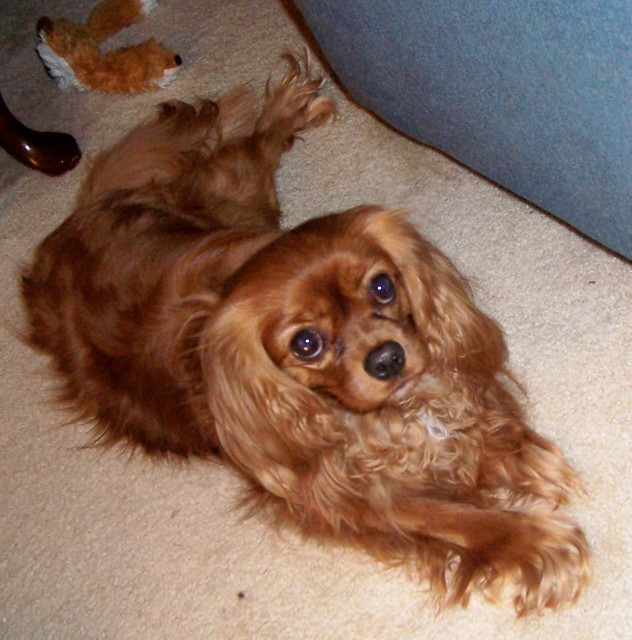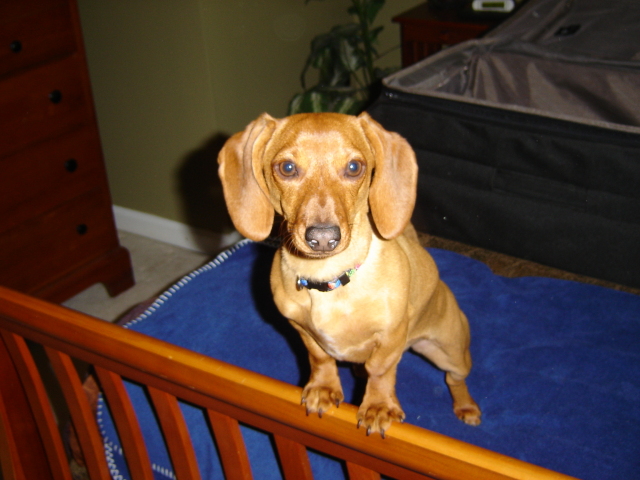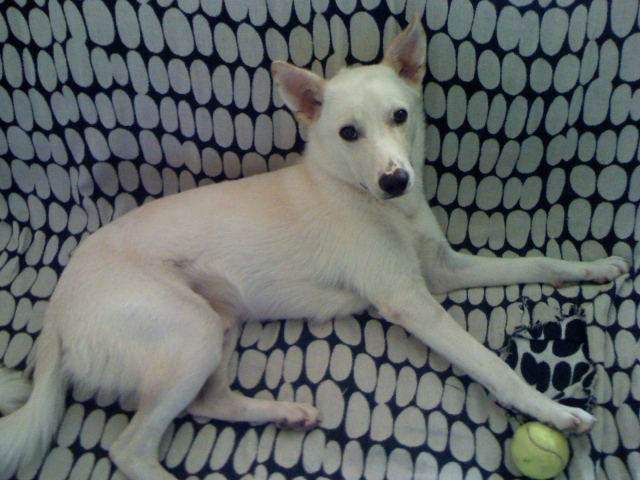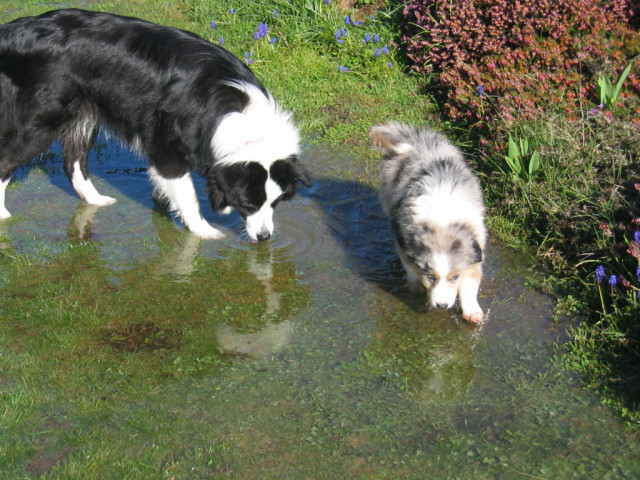QuestionHi Dr. Connor,
Thank you for taking my question. My husband and I recently adopted a 15 mo (est age) old lab/pit bull mix from the humane society. He is the friendliest dog towards people (albeit a little shy and timid at first), but I am concerned about his developing aggressive behavior other dogs. At the shelter (and vet before coming home) he exhibited no signs of aggression at all. In fact, he seemed quite calm and ignored other dogs in those environments. However, since being home he has exhibited keen interest in them as we go on daily walks. He doesn't bark, growl, or lunge. He just stares w/ his head high and looks very alert. He wants to approach them but I am afraid to let him close b/c (perhaps my lack of understanding him), he is unstable around other dogs. Before knowing his new behavior at home, he got into two violent tussles w/ other dogs (once w/ a shit-tzu on a walk who attacked him first; second at Petsmart w/ a pit bull --shame on me for allowing this to happen twice...I thought the first incident was the little dog setting him off and was a one-off behavior given his mellow nature at the shelter). How do I deal w/ this? Am I the one sending him the wrong signals? I really want to socialize him w/ other dogs, particular w/ my parents 18 mos old pug who we love and see once/twice a week but I'm so scared an interaction will end up in a dog fight of which he is 65lbs and likely to cause more harm. Pls help!! Thank you. Michelle
AnswerRight now, you absolutely cannot allow your dog to interact freely with that Pug, given your description of what happened to him at Petsmart. If the Shih Tsu attacked HIM on a walk, this may have set him up for a fear response: I don't understand how a dog can attack another dog on lead unless both dogs were allowed immediate interaction, NEVER a good idea. When a dog is on leash, it is forced (because it is walking alongside a human in the manner that humans walk) into direct "confrontation" with oncoming dogs. This direct confrontation disarms the dog's normal manner of communication. When dogs approach one another, the only time in which it is direct and swift, eye to eye, is one of threatening demeanor, i.e., "I'm coming right at you and I mean business". Most dogs, if left to their own devices, will approach more slowly, or give very clear signal of intention (body language), i.e., calming signals, play signals, etc. SO...when you walk your dog, because you don't *know* the dog culture involves certain approach behaviors, and because you are human and just going about the business of walking, you inadvertently create mistaken signals from your dog (as does the other human with the other dog). This is why it's so important to socialize dogs to all sorts of experiences on leash, so they habituate to this "unnatural" way of approach and learn to compensate for it. The Shih Tsu may have perceived a threat from your dog because of the direct approach or may not be a very dog friendly dog itself; whatever, when a dog experiences such a violent encounter, the dog acquires a quick fear response to the approach of other dogs (especially dogs of that size/type). THEN in Petsmart the other incident occurred. I sometimes shop there in my area and I have seen MANY dogs there that did not belong there: dogs whose reaction to the presence of another dog was a clear indication of lack of proper socialization or problem behaviors. BUT you can't stop idiots from hauling their poorly trained, badly behaved, improperly socialized dogs around!
Behavior in any shelter environment is quite difficult to use as a determinant of temperament, unless you really know what to look for and how to conduct a temperament test. Dogs are naturally subdued in such an environment (although they appear hysterical when people walk through), are artificially demoted psychologically, are fearful and can even appear timid, and unless the shelter is privately owned with dog walkers, a trainer, etc., evaluating the dog's daily behavior you have no one to ask regarding temperament. Public shelters are not the place to ask advice regarding temperament of a dog: they simply don't know, or they think they know, or they pass on information from "owners" who dumped the dog there (and who lie). So you really do NOT know this dog's temperament toward other dogs and you barely understand him in the environment of your home; he has yet to settle in and find his place (a place YOU should be giving him, not his selection). This is done by using positive reinforcement training to teach several simple behaviors (using different words from the normal "sit", "down", etc. since other people have most likely rendered those words meaningless or worse) in short sessions over the course of the first weeks. The dog should be confined when you are not at home and closely observed when you are at home; he should not be allowed to wander the house, he should be kept off furniture and out of bedrooms, and be asked to "sit" BEFORE AND AFTER being taken outdoors AND before meals and treats. Calm, consistent leadership will help him to find his place under YOU and help prevent development of separation anxiety (a huge problem in re-homed dogs).
Regarding your fear: if you are afraid, it goes straight down the leash to the dog. Not only can he smell the adrenaline on your breath (take tic tacs with you) but he can READ your body language (and is doing that constantly, especially in the first months). If you're fearful you won't be able to easily hide it unless you're quite vigilant about your own reactions and this is very difficult: you have a large, strong dog and you've already encountered two problems. Your dog's posture (head up, ears erect, bright eyed) is not the entire communication, there are other signals he's giving that you're missing (because everyone can't possibly "talk dog"!) He may very well be presenting with a dominant, in-your-face demeanor toward an approaching dog but he may also be showing signs of excitement. I suggest you learn about dog body communication by going to Turid Rugaas' website:
http://www.canis.no/rugaas/index.php
She also has a book and video, "On Talking Terms with Dogs: Calming Signals" available here:
http://www.dogwise.com/itemdetails.cfm?ID=DTB527
You will be able to learn to read THE OTHER DOG as well as your own, in the first moments BEFORE there's a connection, as they approach one another. If your dog's posture is clearly "in-your-face" with no offer of calming signals or greeting signals, the other dog should be demonstrating an immediate defense/avoidance reaction: lots of lip licking, or raised hackles, barking, turning of head, etc. Don't allow interaction right now as you need to do some work with your dog before doing so, just observe and do it consistently so you can learn more about your own dog's motivation/drive and what sort of reaction he's actually having (that you may be misperceiving). What you do NOT want is another problem incident, as each one will worsen your dog's next encounter. What you DO want is to calmly go in the opposite direction (once you've made a quick assessment of what the dogs are "saying" to one another) and "work" your dog, for food reward, by changing direction (the moment he makes eye contact with you and changes direction, pop treat in his mouth) and, as your training progresses, then asking for "sit" for food reward, until the other dog has passed. This gives you more confidence that a fight won't ensue and also demonstrates to the dog that you are in control, that "working" with another dog present is rewarding, and will help to desensitize him as other dogs approach. This is a stopgap measure while you do the next thing:
which is to look for a positive reinforcement training venue where you can interact with other dogs (on leash) in a group novice obedience class or a "growl" class (class especially designed to sort through problem behaviors, dog to dog, dog to 'strangers' when on leash, etc.) Be sure the trainer in charge is credentialed (national training organization), ask for several references (and check them) and observe a class or two before attending with your dog. If you're satisfied that the trainer is sophisticated enough to understand the dynamics between dogs and experienced enough to conduct an intervention, explain to him/her the situation (as described to me) and what you have been doing thus far and learning. In this venue, your dog will be observed by a professional who can more easily determine what's really going on in his mind in the presence of other dogs (on leash). The ultimate aim of such training is to teach your dog what you will see in the following video:
http://www.youtube.com/watch?v=9zQAgY-fk6A
As you will see, the dogs in this video are all very well trained to 'follow' on command, 'sit' on command (in every environment) and have already achieved confidence on leash in the presence of other dogs. It will take quite a while for your dog to achieve this sort of control (especially 'sit' on command outdoors and as other dogs approach) but this is your goal.
If you are unable to find a training venue such as I described, you'll need to work on developing trained behaviors alone and you can do so by going to Dr. Ian Dunbar's video training textbook:
http://www.youtube.com/watch?v=Hv38ornzzuQ
I prefer to use a clicker when addressing serious problem behaviors, since that instrument instantly communicates to the dog "THAT BEHAVIOR is about to be rewarded", and it's easy to substitute the clicker for the immediate treat (instead of popping treat into mouth or praising, click, then treat). In this way, a dog can be "told" that his calming signal (which occurs in an instant) will be rewarded because the click immediately coincides with the calming signal and the treat can follow within 30 seconds. To incorporate the clicker into your training regimen, read Karen Pryor's "Getting Started: Clicker Training for Dogs" and going to her website, this specific part of which deals with eliminating unwanted behaviors:
http://www.clickertraining.com/node/834
If you feel overwhelmed by all of this, find a positive reinforcement trainer who will come to your home, evaluate your dog and then address the problem(s) you're having, starting with the most important one: the dog to dog approach on walks. To locate one, call around the veterinary clinics; be sure the trainer has credentials (not just someone with an ad in a pennysaver), be ABSOLUTELY sure this person uses ONLY positive reinforcement (NO choker collar, remote collar, prong collar, punishment, coercion, jerking leash, etc.), ask for a few references, and then let your first meeting be an "interview" where you observe the trainer's ease (or disease) with your dog and yourself. If you don't like someone, DO NOT hire them.
When you say you acquired the dog at a "humane society" I'm unsure what this means, as many people call the public kill shelters "humane societies"; even if this IS an actual "humane society", they're not all created equal. I was in one downstate NY a few years ago that was abominable. Some are marvelous places. If this is an actual 'humane' society, call and ask if they have a trainer on staff who knows this dog and explain the problem. If they know the dog well (which they should if they're doing it right), they may offer some advice and counsel.
Meanwhile, have your dog meet the Pug on leash in NEUTRAL territory; do NOT approach directly (eye to eye, head on); instead, walk parallel to one another (with plenty of space between) and reward your dog for his CALM demeanor by calling his name, making direct eye contact with him, and giving him a tiny treat, consistently as you walk. Once he's adjusted to the presence of the Pug (and vice versa), get a little closer; keep walking in this manner until your dog has clearly begun to be calm (and even a little bored) with the Pug (and vice versa) and then stop, ask both dogs to "sit" (even if you have to bait your dog to do so by holding a treat over his head, which "forces" a dog down on its haunches as he looks up at the treat) and carry on a conversation together, all the time of course actually observing both dogs. Then stop, casually go in different directions. Repeat the next day or two days later, then again, until the two dogs can see one another with only a few seconds of excitement AND have clearly learned to "sit" and allow a conversation. At this point, you can slacken the leash and observe body language, you should have learned enough to be able to read your dog's intent. If at any time you think he is about to become aggressive (from clear body language), simply go quickly in the opposite direction, then circle left, then right, stop and "sit" the dog, as the other dog leaves. If, however (which is more likely) the two have become habituated to meet/greet as described (while "sitting") and seem to be developing a normal greeting interaction, you can then repeat this a few more times and plan to take your dog into the other dog's home. Start on the sidewalk in front, move to the yard, keep both dogs leashed and allow developing interaction, then stop. Do this a few times until both dogs are now clearly relaxed (after first greeting) with one another, then allow them off leash (drop your dog's leash so you can easily step on it or pick it up should something develop). You will be be able to take them indoors when you're comfortable with what you see. All this seems elaborate but it's intended not only to protect the Pug from injury but to put your dog at ease and help him to habituate to the other dog; this doesn't mean he'll necessarily be happy to see the Pug ON HIS turf (your home). I can't see anything from here, so I choose the side of caution.

 Dog light and shadow chasing
Question
Jenni
My 3 year old Cavalier King Charles Span
Dog light and shadow chasing
Question
Jenni
My 3 year old Cavalier King Charles Span
 Post bladder surgery potty training for INDOORS!
QuestionTiki
QUESTION: Dear Dr. Connor,
My 10 ye
Post bladder surgery potty training for INDOORS!
QuestionTiki
QUESTION: Dear Dr. Connor,
My 10 ye
 Mini Daschund with anxiety issues
QuestionAbigayle
QUESTION: I have a 3 1/2 yr old
Mini Daschund with anxiety issues
QuestionAbigayle
QUESTION: I have a 3 1/2 yr old
 Dog walking problems
Question
Snickers
I have been trying to train my dog SN
Dog walking problems
Question
Snickers
I have been trying to train my dog SN
 Dog in Heat?
QuestionLily and Jorge
QUESTION: Hello,
We have
Dog in Heat?
QuestionLily and Jorge
QUESTION: Hello,
We have